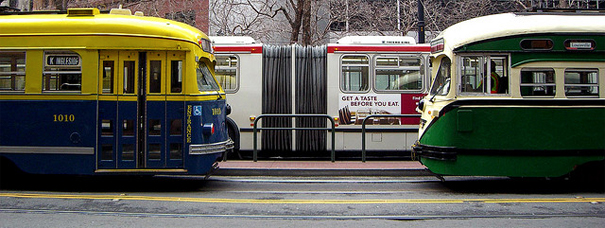On Rails & Tires
An often discussed theme in transit planning is the various pros and cons of trains and buses. Â The basic assumption goes like this: Rail is preferred, but it costs more. Buses aren’t as nice, but are much cheaper. Jarrett Walker at HumanTransit.org wrote a somewhat provocative article in 2009, trying to capture what the aversion to buses are when compared to streetcars, despite many advantages of buses:
Streetcars do attract more ridership than the buses they replace, though it’s not always clear why. Â There’s an urgent need for more research on how much of the ridership benefits of a streetcar are truly results of intrinsic benefits of the streetcar (such as the ride quality, the legibility provided by tracks in the street, etc) as opposed to results of other improvements introduced at the same time (including speed and reliability improvements, better public information, off-board fare collection, and possible differences in operations culture).
[If] you want a streetcar because it’s intrinsically faster and more reliable than a bus — well, that’s just not true.
At Nextransit, we firmly believe that rail simply offers a better user experience. Â In theory, or at least on paper, one could develop a bus line that follows the exact same patterns as rail: multiple door boarding, covered platforms, dedicated busways, electrified buses. Â Yet there are some examples of this, like the Silver Line in Boston, and they still do not have the same “feel” as rail.
In the technology world, the “look and feel” are of utmost importance in designing a website, a product, or an app. Â If it doesn’t feel right, it won’t appeal to the user. Â Sure, we can use inferior products, but whenever presented with an alternative option, we’ll generally choose the better feel, even if it’s slightly less ideal to what we’re interested in doing.
So is this always true? Â Can a bus-tram change this feeling, or is it in the small details: the side-to-side sway of a bus, the different sounds, the friction of pavement instead of the metal of rail?
While it remains to be seen if buses can truly ever live up to their rail counterparts, we think a lot can be done to improve the bus experience, particularly when it comes to navigation. In the coming weeks we’ll be introducing our first iPhone app that takes a baby step at treating buses in ways we treat rail. Â If we can remove the psychological barriers to buses, maybe at the minimum we can improve the look and feel of riding a bus, even if we can’t make buses stop hitting potholes or getting stuck in traffic.
